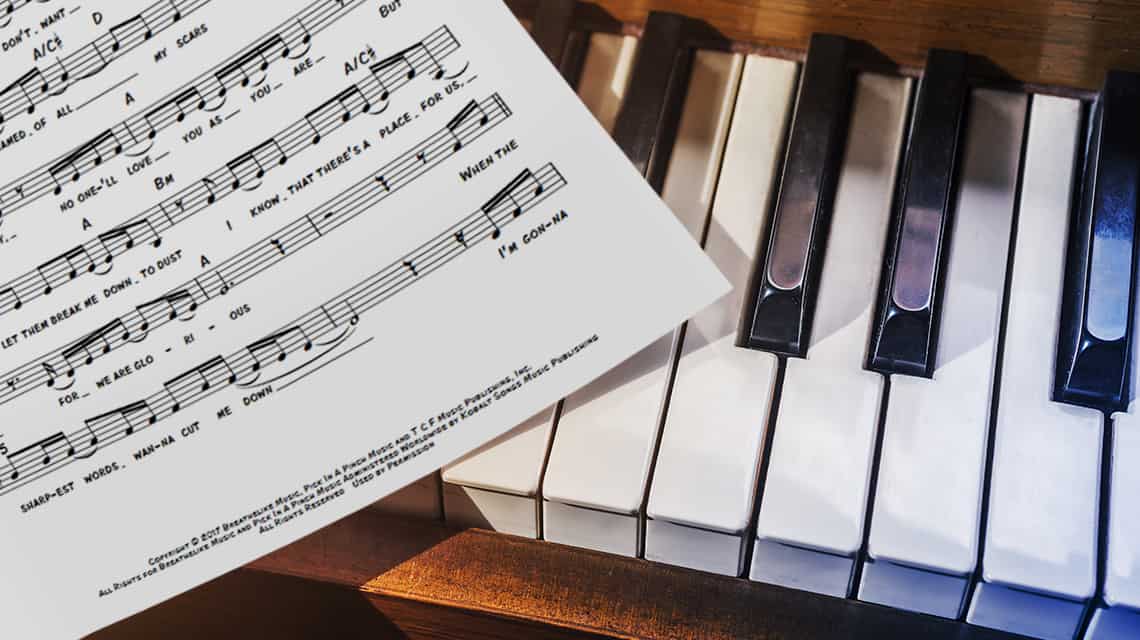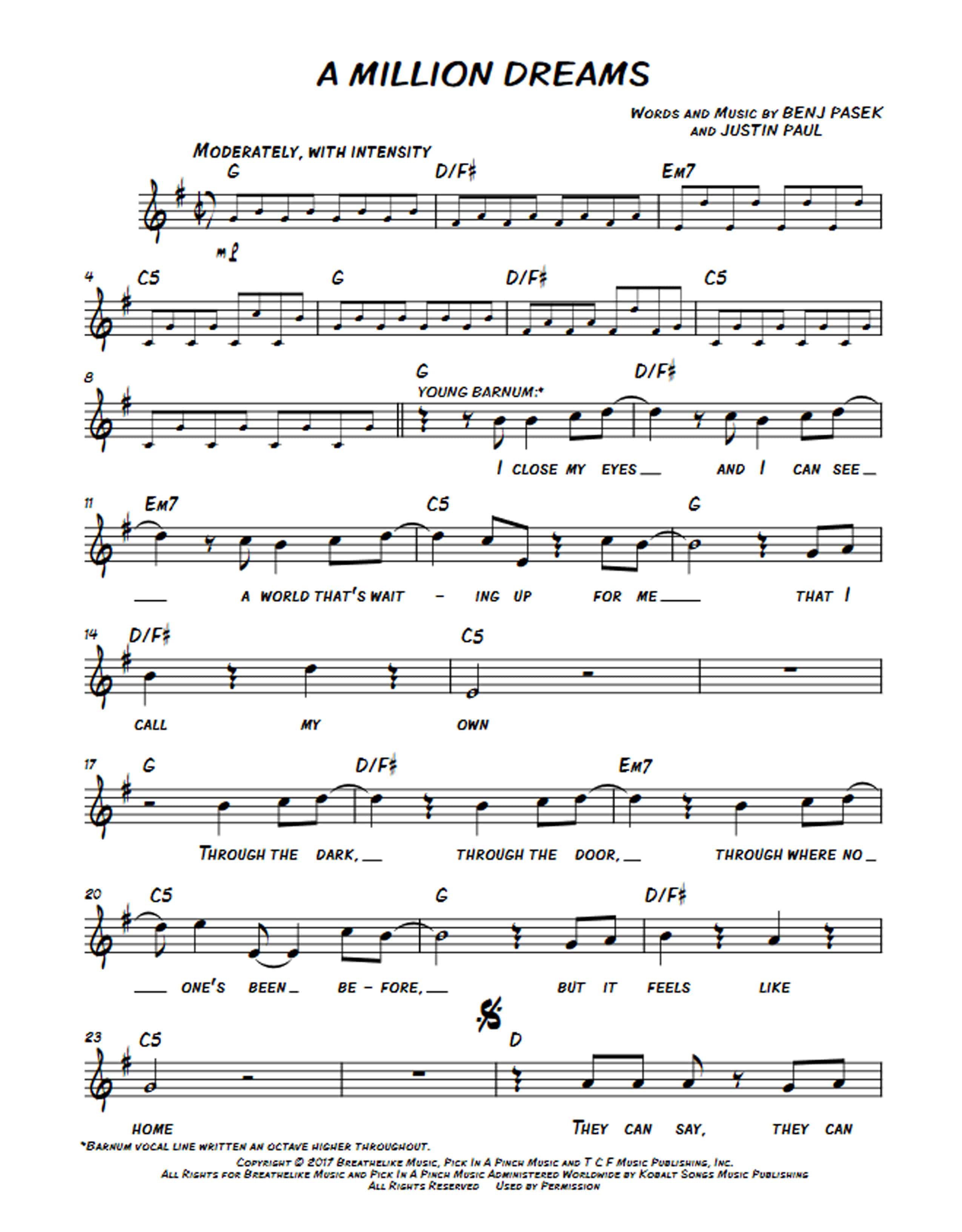How To Read A Chord Chart Or Lead Sheet At The Piano

Many people begin their study of the piano by learning to read notation on the staff. This is definitely a smart approach to learning the piano, but a well-rounded pianist will also learn how to read piano chord charts or lead sheets. One method is not better than the other. They complement each other and help build piano skills overall.
Pianists need as many tools as possible in their musical toolbox. If you are a strong music sight-reader and can also play from a piano chord chart, you’ll be able to play many different types of music in a variety of venues which gives you more earning potential down the road.
What Is A Chord Chart Or Lead Sheet
Chord charts and lead sheets are really similar, with one main difference.
A chord chart shows chord symbols and which beats to play those chords on. It may or may not include lyrics.
In the example below, you see the name of the chord when you first strike the chord and \ for each time you repeat that same chord.
C \ \ \ Am \ \ \ F \ \ \ G \ \ \
A lead sheet will include these same chord symbols, except that they are shown above a notated melody line in the treble clef.

Sometimes lead sheets have the slash marks to show which beats to play on and other times they are left off and the chord rhythms can be inferred from the line of notation.
Why It Is a Good Idea To Learn Your Piano Chords
It allows for creativity at the piano.
When you are reading music notation, you are locked into what is written on the page. While you can use your creativity in how you play these notes, there isn’t much creativity when it comes to what you are playing.
One the other hand, playing from a chord chart or lead sheet allows for a good bit of improvisation. You can choose the style and rhythms of your performance. If you are performing with others, as in a little jazz combo, you can take musical cues from each other and play off each other more freely.
It makes it easy to accompany singing and other instruments.
Often, when a piano is accompanying a singer or instrumentalist, the piano is there to lay a foundation of harmony and rhythm, while the singer or instrumentalist carries the melody. When you can work from a chord chart or lead sheet, you can instantly create simple accompaniments to complement other musicians.
Many pianists enjoy singing along with their own playing in this format as well.
It helps pianists see and understand chords differently.
Playing from a lead sheet gives you insight into the structure and form of a piece. It’s a great way to learn basic compositional skills and expand your harmonic vocabulary. This is especially helpful to any pianist who wants to write their own songs.

How To You Read A Chord Chart
Reading a chord chart requires you to use your ears to anticipate harmonic progressions and correctly interpret the style of the piece. A simple way to play this example would be to give each chord a quarter note value.
C \ \ \ Am \ \ \ F \ \ \ G \ \ \
There is room to play with the rhythms, however. As long as each chord occupies four beats, you can mix it up and incorporate different note values.
Since this type of chording does not require you to play a melody in the right hand, the most common way of interpreting a chord chart is to play the chords in the right hand and a bass note in the left hand. The bass note should be the root of the chord unless otherwise indicated by the chord symbol.
For example, the chord symbol “C” means you will play the note C in the bass while the right hand plays a C chord. The chord symbol “C/E” means you will play an E in the bass while the right hand plays a C chord.
A chord chart may or may not have a time signature to guide you so you’ll have to notice how chords are grouped or listen to the music to learn which meter fits the best.
For example, this is similar to the chord progression we just looked at, except that the chords come in groups of 3 rather than 4. This would tell you that you’re in 3/4 time.
C \ \ Am \ \ F \ \ G \ \
How Do You Read A Lead Sheet
You’ll read a lead sheet in a very similar way. However, with a notated line of music, you’ll have a time signature to help you know how to count the beat right away.

With a lead sheet you can also take cues from the melody line to give you ideas about what to play.
The rhythm of the melody might give you ideas about what types of rhythms would work best of what that particular song.
You can work the melody line into your chords if you would like to hear the melody on the piano. You can create a counter melody or harmonic line to accompany the melody. The options are endless when it comes to reading from a lead sheet.
There is no right or wrong way to play and the best way to learn is to just start playing around with chords from a lead sheet and find what works.
What Piano Skills Do You Need To Know To Play From A Chord Chart
-How To Build Chords
Knowing how to build chords is the most important skill needed in order to play from a chord chart or lead sheet. You’ll also need to know chord-related symbols and terminology.
For example, chords can be major, minor, augmented, or diminished. Major chords are often written with an uppercase letter and minor chords can be written with a lowercase letter or a lowercase “m” following the chord name. Augmented chords are indicated with a plus sign or “Aug.” Diminished chords are shown with a degree sign or “dim.”
There are also diminished, augmented, and seventh chords that may show up in music.
-How To Invert Chords
You will also need to know invert chords. When a chord is in its root position, it is named after the lowest sounding note and the other two notes are space evenly, a third apart.
A root position chord can be seen here:

When you invert a chord once, you move the lowest note to the top of the chord and the middle note becomes the new lowest sounding note. You can invert it a second time and what was originally the highest note is now the lowest note.
Because seventh chords have a fourth pitch, they have one more inversion. The third inversion is when the seventh is in the bass of the chord. It’s important that you can identify and play chords in root position and in both inversions.
Piano chords sound and work the best when you play a variety of inversions. If you keep everything in root position, your hand will be jumping all over the piano and the music will sound really choppy. However, using inversions will help you to move between chords with ease and the transitions between chords will sound much smoother.
-Create a bass line
You will usually play chords with your right hand, so your left hand will be responsible for creating a bass line to support your chords.
A lot of times your left hand can double the root note of your chord. For example, if you have a C Major chord in your right hand, you can play a single bass C note in the left hand.
If your chord symbol includes a “/“ you will have a different bass note in the left hand.
For example:
C \ \ \ F \ \ \ C/G \ \ \ G \ \ \ C
C/G indicates that you will have a C chord in your right hand with a single G note in your left hand. Let your bass line serve as the rhythmic foundation. Use it to add syncopation or repeated notes to the piece.

How To Get Creative With Chord Charts And Lead Sheets
It can see boring to play chord charts and lead sheets at first. With little guidance about what to do, it might seem like you’re just holding really long chords or playing the same chords over and over.
Once you get comfortable building and playing chords, spend as much time as you can playing around with the chords and experimenting. It definitely helps to play along with some prerecorded music or with another musician so that you can feel the music and practice changing chords quickly and smoothly.
Here are some things you can try as you’re experimenting with chords:
Arpeggiate– we often first play chords blocked, or with all the notes sounding simultaneously, but you can also arpeggiate your chords so that each note sounds independently. A lot of times, we play arpeggios from low to high, but you can really play the notes of broken chords in any order. Find patterns that sound interesting and that are fun to play.
Passing Tones– Passing tones exactly what they sound like. They are notes that you can use to pass from one chord to the next. As you are practicing transitioning between chords, you can use passing tones to fill in gaps between chords.
Changing Rhythms– Sometimes it’s easy to get stuck playing the same rhythm over and over, such as all quarter notes or all eighth notes. Find different rhythmic patterns to include. You don’t have to repeat the same rhythm over and over throughout a song, so find a few that work well together and alternate between them.
Dotted Rhythms– Using dotted rhythms is a really easy way to make your music sound more interesting. A dotted quarter note + an eighth note or dotted eighth notes + sixteenths can make your music sound much more lively and engaging.
Left Hand Octaves– Your left hand can play single bass notes to start out, but octaves in the left hand will make your music sound much fuller. You could also play or arpeggiate and octave + a fifth, for example, C-G-C, in the left hand. This is a really common left hand pattern on the piano. It’s easy to play and it can instantly make music sound much more interesting.
Be careful not to completely repeat the same chords from your right hand in your left hand. Full chords in the left hand can sound really muddy. If you’re already playing a chord in your right hand find something different for the left hand.
Walking Bass LineBass lines work really well when the notes walk step-wise from one note to the next. For example moving from C – B – A – G.
Even if your chords don’t indicate to play an inversion, you can use a different bass note than the root if it helps keep your bass line in order.
Or, your bass line can also include passing tones. For example, if your chord progression has you moving from C – Am, your bass line could start on a C and pass through a B before arriving at the A.
Bass lines don’t have to walk, so don’t worry if your bass line jumps around a bit. But, once you start playing around with walking bass lines you’ll discover that they’re really easy to play and they make the music sound really put-together.

